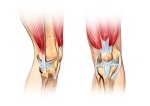
Norbert' remember as a kid singing Dem Bones? Yeah, but I'm not gonna sing it for you. Thank goodness because I've got something better: The toe bone's connected to the foot bone, The foot bone's connected to the ankle bone, The ankle bone's connected to the leg bone, Now shake dem skeleton bones!
The leg bone's connected to the knee bone, The knee bone's connected to the thigh bone, The thigh bone's connected to the hip bone, Now shake dem skeleton bones!
Dem bones, dem bones, dem dry bones, Dem bones, dem bones, dem dry bones, Dem bones, dem bones, dem dry bones, Now shake dem skeleton bones! Did you get your students to sing this, Dave? Pretty cool! Yeah, they sound great, right?
Anyway, it's a perfect segue into our episode about a bone called the fabella' Ooh, I know, here's a modern take on Dem Bones, ' 'the fabella is connected to the knee bone'. Whoa ' leave the singing to the students, will ya? Thanks, Norbert.. Fine fine. But listen, the fabella has a cool story. So, it's a small bone in one of the tendons in the back of your knee, but through evolution, it has mostly been lost. What's crazy is that the fabella is making a comeback in human populations!
Researchers have examined the structure of the knee in more than twenty thousand cases over one hundred fifty years. In nineteen eighteen, just eleven percent of people had it, but a century later, in two thousand eighteen, almost forty percent of people have it!
That's a fourfold increase in hardly a blink in evolutionary time. So, why is this bone reappearing? Mainly because we're better nourished, have longer shinbones and calf muscles, and we're taller. This changes the mechanical dynamics of how we move, the forces on our bones and skeleton. This means our knees work harder which may favor the formation of the fabella.
Of course, genetic influences can't be ruled out. We don't know the true function of the fabella in the knee, but here's evidence that humans are still evolving.
More Information
Fabella prevalence rate increases over 150 years, and rates of other sesamoid bones remain constant: a systematic review
The fabella is a sesamoid bone located behind the lateral femoral condyle. It is common in non-human mammals, but the prevalence rates in humans vary from 3 to 87%. Here, we calculate the prevalence of the fabella in a Korean population and investigate possible temporal shifts in prevalence rate. A total of 52.83% of our individuals and 44.34% of our knees had fabellae detectable by computed tomography scanning...
Tiny Knee Bone, Once Lost in Humans, Is Making a Comeback
TThe fabella disappeared from our lineage millions of years ago, but over the last century, its presence in people's knees has become more common...